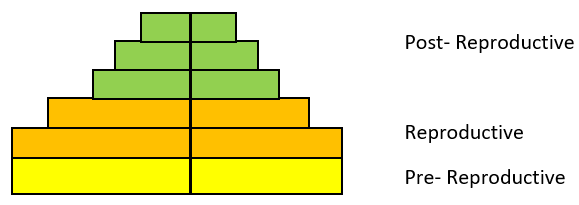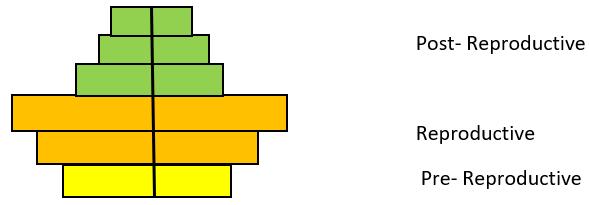This set of Class 12 Biology Chapter 13 Multiple Choice Questions & Answers (MCQs) focuses on “Population Attributes – 1”.
1. What is a group of individuals belonging to the same species called?
a) Community
b) Population
c) Order
d) Family
View Answer
Explanation: The population is the level of the organization after an organism. Various organisms come together and start residing at the same place known as population. It has organisms of the same species.
2. To which species do human beings belong?
a) Homo sapiens
b) Homo erectus
c) Homo neanderthalenis
d) Homo habilis
View Answer
Explanation: Humans belong to the species of Homo habilis. It lived approximately between 2.1-2.4 and 1.5 million years ago. It is an archaic species that lived in the early Pleistocene. Today’s human species is called Homo sapiens.
3. What is the changing nature of the population called?
a) Discovery
b) Dynamics of population
c) Demography
d) Democracy
View Answer
Explanation: The human population is dynamic. Thus the changing nature of the human population is called the dynamics of the human population. The dynamic studies include the size and age composition of the human population.
4. Which one of the following indicates the study of quantitative and statistical aspects of the human population?
a) Dynamic of population
b) Democracy
c) Census
d) Demography
View Answer
Explanation: The demography is the study of quantitative and statistical aspects of the human population. The study of statistics such as deaths, births, income, incidences of various diseases is included. This study tells about the changing structure of the human population.
5. Who firstly used the term ‘demography’?
a) Darwin
b) Miller
c) Guillard
d) Louis Pasteur
View Answer
Explanation: The term ‘demography’ was first used by Achille Guillard in 1855. It is the study of quantitative and statistical (deaths, births, income, incidences of various diseases) aspects of the human population. It is useful for bio-anthropological investigations.
6. What does population density mean?
a) The number of animals and plants present in a given area
b) The number of individuals in a unit area in a unit time
c) The concentration of human population
d) The number of animals and plants present in a given area
View Answer
Explanation: The population density tells about the number of individuals in a unit area at a specific time. It is a geographical term. Countries with high population density are said to be over-populated.
7. Which among the following options fall under the category of pre-reproductive age?
a) 15-19 years
b) 25-30 years
c) 50-60 years
d) 0-14 years
View Answer
Explanation: The pre-reproductive age is 0-14 years. It is the age before puberty. It is the age before females become fertile and can carry children.
8. Which among the following options fall under the category of reproductive age?
a) 23-54 years
b) 0-14 years
c) 15-49 years
d) 50-70 years
View Answer
Explanation: The age individuals of 15-49 years are considered as the reproductive age group. It is the age group in which females become fertile and have the child-bearing capacity.
9. Which among the following options fall under the category of post-reproductive age?
a) 23-54 years
b) 0-14 years
c) 15-19 years
d) 50 years and above
View Answer
Explanation: The individuals above 50 years fall under the category of post-reproductive age. These are the years during which female fertility declines and have fewer chances of bearing children.
10. What is the population having a large number of individuals in pre-reproductive age called?
a) Reproductive population
b) Steady population
c) Growing population
d) Declining population
View Answer
Explanation: The population having a large number of individuals in the pre-reproductive age is called a growing population. It is so-called because fertile females can give rise to more children thus increasing the population.
11. What is the population having a large number of individuals in a post-reproductive age called?
a) Growing population
b) Declining population
c) Steady population
d) Reproductive population
View Answer
Explanation: The population has a large number of individuals in a post-reproductive age is called a declining population. It is so-called because there will be fewer births and more deaths thus indicating negative population growth.
12. What is the population having the same number of individuals in the pre-reproductive post-reproductive age called?
a) Growing population
b) Reproductive population
c) Steady population
d) Declining population
View Answer
Explanation: The population has the same number of individuals in the pre-reproductive post-reproductive age is called a steady population. It is the population in which the birth rate is approximately equal to the death rate.

13. What does the following diagram indicate?
a) Declining population
b) Expanding population
c) Steady population
d) Reproductive isolation
View Answer
Explanation: The following pyramid indicates the expanding population. It is a triangular age pyramid in which the individuals in pre-reproductive age are more, moderate in reproductive age while fewer individuals are present in post-reproductive age.

14. What does the following diagram indicate?
a) Declining population
b) Expanding population
c) Reproductive isolation
d) Steady population
View Answer
Explanation: The following pyramid indicates a steady population. It is a bell-shaped pyramid in which the individuals in pre-reproductive and reproductive age are almost equal while fewer individuals are present in post-reproductive age.

15. What does the following diagram indicate?
a) Declining population
b) Reproductive isolation
c) Steady population
d) Expanding population
View Answer
Explanation: The above pyramid indicates that it is a declining population. It is an urn-shaped pyramid in which more number of individuals is present in reproductive age as compared to pre-reproductive age. It indicates the negative growth of the population.
Sanfoundry Global Education & Learning Series – Biology – Class 12.
To practice all chapters and topics of class 12 Biology, here is complete set of 1000+ Multiple Choice Questions and Answers.
If you find a mistake in question / option / answer, kindly take a screenshot and email to [email protected]
- Practice Class 12 - Physics MCQs
- Practice Class 11 - Biology MCQs
- Check Class 12 - Biology Books
- Practice Class 12 - Mathematics MCQs
- Practice Class 12 - Chemistry MCQs
